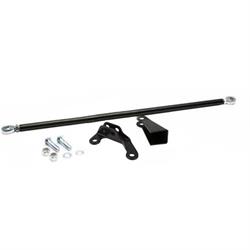Solid Axle Front Suspension Options
If we look back to the Model T era up until the late 1940’s, Ford used a solid I-beam front axle supported by a transverse leaf spring (runs lengthwise with the axle). The front axle pivoted off of what is known as a wishbone – a triangulated locator with arms running from each end of the front axle back to a single pivot point near the transmission. Ford’s original design worked well for its era and its purpose, allowing a large range of suspension travel. The basic transverse-leaf design is still used on many street rod applications, though with a wide range of refinements that have been developed by rodders and the aftermarket through the years.
As the use of bigger engines and lowered suspension designs became popular among hot rodders, interference problems meant an alternative to the original wishbone design was needed. The solution developed by early rodders helped define the traditional hot rod look we see today. Using a little ingenuity, hot rodders would split the original wishbone at its pivot point, creating two locating arms that could be mounted further apart to allow more engine and transmission clearance.
From these beginnings, many variations of solid axle front suspension designs have developed. Many rodders began using purpose-built hairpin-style radius rods instead of split wishbones and, in later years, four-bar style suspensions gained in popularity. As a street rodder, depending on your front suspension design and the appearance you’re trying to achieve, there are three basic options to choose from.
Split Wishbone
For the traditionalist, Speedway offers a wishbone splitting kit that allows you to split your original Ford wishbone assembly. Kits can be supplied with either 7 degree tapered tie rod ends, PN 91645140, or 11/16-inch rod ends, PN 91645142. Once split, the wishbones can be attached to your frame using one of several styles of brackets (91635050 and similar), or with a combination transmission/wishbone mount PN 9161940. Another option is to use Speedway’s Wishbone-Style Radius Rods, both standard like PN 91645127, or lightened with holes, PN 91645128. These are new manufactured steel arms with forged front yolks that deliver the traditional split wishbone look without the need to locate or modify an original wishbone.
Hairpin and Curtis Style
Both hairpin and Curtis-style radius rods will still offer a traditional look for your early solid axle street rod. We typically we see them used on ’34-and-earlier cars with spring-over or spring-behind suspensions. Speedway offers both a 27” Hairpin radius rod and a 36” Curtis style radius rod,plus a wide range of brackets for attaching them to your frame and front axle.
Four Bar
A Four-bar design is engineered to allow the front suspension to travel freely at all angles, which improves ride quality and handling. With Ford’s original wishbone front end, the wishbone limited side to side movement. Even with wider axle mounting points, the split wishbone or radius rod design will provide some measure of triangulation to help control side motion. However, a four bar design cannot control side to side motion, so it should be considered mandatory to use a panhard bar on all four-bar systems. Speedway carries Four-bar suspension kits for Model A, '32 to '34 Ford, and '35 to '40 which are recommended to be used with stock style or tube axle front ends.






